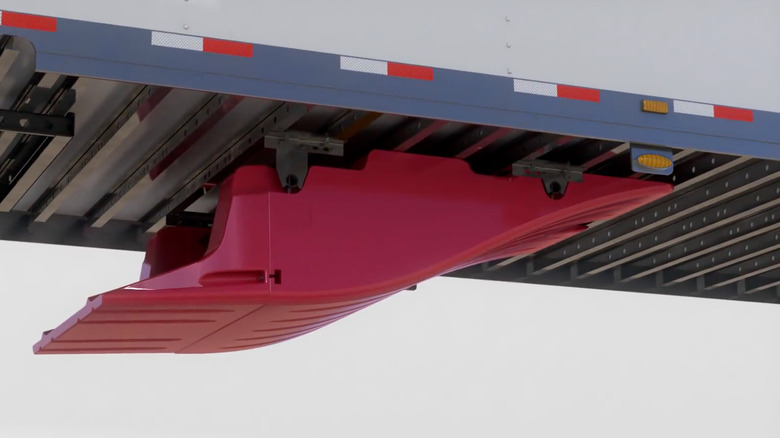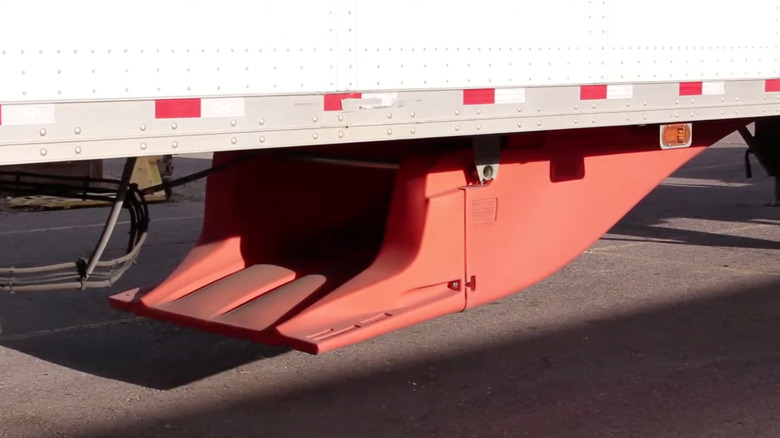What Is The Big Plastic Scoop Under Some Semi-Trucks For?
Given their enormous size, it's strange to think that semi-truck fleets actually care a great deal about aerodynamics. Whether it be the installation of angled fins on the side or the addition of flaps on the back, semi-trucks actually have good reason to want to cut down on their drag: Doing so saves fuel and makes their trucks more efficient. And for an industry where fuel consumption is a constant concern, even a small increase in miles per gallon (MPG) can lead to huge cost savings over time.
A growing trend in the ongoing semi-truck aerodynamic efforts? Those large, curvy plastic panels mounted beneath the trailer. These odd-looking things, officially known as UnderTray systems, are designed to manipulate the airflow underneath the trailer to cut down on drag. Think of it like this: As a semi-truck barrels down the highway, air rushes underneath the trailer. This air typically sits about four feet off the ground. Without anything down there to dissipate it, that air slams into the axles and rear wheels, creates turbulence, and increases drag.
The more drag there is, the harder the truck's engine has to work to push the vehicle forward. This, in turn, burns more fuel. The UnderTray acts as a wedge of sorts, splitting and redirecting the air away from the rear wheels, effectively reducing resistance.
Why should semi-trucks care about aerodynamics?
Fuel efficiency is obviously quite important in the trucking industry. This makes aerodynamic upgrades like the UnderTray well worth the money if the end result is lower operational costs. After all, on a good day, a semi-truck's average miles per gallon is only about 6 to 8 MPG. Over thousands of miles, even one additional MPG could bring major fuel savings. And, if UnderTray manufacturers are to be believed, these things can boost fuel efficiency by 10% or more.
That's ultimately why companies adopt these plastic slide-looking things: they're saving fuel and improving efficiency. Less drag, less strain on the engine and drivetrain, fewer breakdowns, and lower maintenance costs over the long haul. What's not to like?
Of course, the UnderTray is just one piece of the larger puzzle that is aerodynamics. Semi-trucks experience drag in four main areas: the front of the tractor, the gap between the tractor and trailer, the sides and underbody of the trailer, and the rear of the trailer. Each of these zones contributes to the overall aerodynamic drag.
How to make semi-trucks more aerodynamic
UnderTray systems typically come with two key components: one in front of the trailer axles and one behind them. But a driver's best bet? An UnderTray system combined with skirts on the sides and flaps on the back of the semi. This multi-part system can help manage airflow both around and beneath the trailer. Together, these improvements have reportedly helped fleets increase fuel efficiency by as much as 15 to 25% or more. Throw in extras like wheel covers and aerodynamic mud flaps, and drivers can increase that number even more.
As it turns out, that strange plastic scoop under a semi-truck is far more than just a quirky design element: It's part of a specific effort to make one of the most fuel-hungry vehicles on the road more efficient. And with so much uncertainty surrounding fuel prices, regulations, and environmental concerns, more efficiency isn't just something that would be nice to have — it's practically a necessity.


